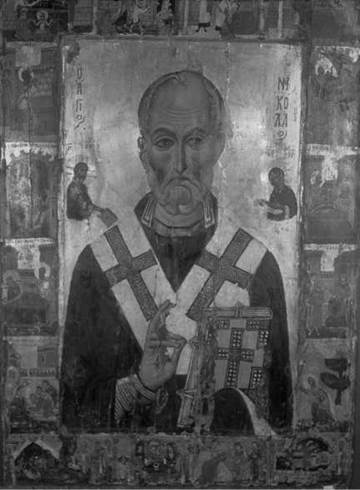St. Nicholas the Wonderworker
MARIA GWYN MCDOWELL
A “super-saint” (Onasch 1963:205) in whom the “Church sees ... a personification of a shepherd, of its defender and intercessor” (Ouspensky and Lossky 1982: 120), the received story of St. Nicholas the Wonderworker is a conflation of the 4th- century Nicholas of Myra and the historical 6th- century Nicholas of Sion (d. 564).
Nicholas of Sion’s cult was well established by the end of the 6th century, aided by his Life written soon after his death by a disciple (Sevcenko and Sevcenko 1985: 11). To this abbot of the Monastery of Holy Sion and later bishop of Pinara belong the popular birth miracles, felling of the cypress tree, miracles at sea, and many healings (ibid.: 13). Exemplifying a “down-to-earth piety” (ibid.: 15), the Life is modeled after the New Testament and Psalms. Its historical credence is partly due to its detail, which likely reflects firsthand knowledge of itemized monastery records; for example, the amount of oxen Nicholas ordered slaughtered to feed the populace after the bubonic plague of 541–2. The Life also refers to the earlier St. Nicholas who had a coastal shrine in or near Myra. This earlier saint’s small 6th-century cult engulfed that of Nicholas of Sion by the 10th century – the distinction between the two saints blurred by the extensive borrowing of Byzantine hagiographers from the later Life on behalf of St. Nicholas of Myra.

The earliest known account of Nicholas of Myra is likely the Vita per Michaelem from the 10th century, though isolated stories appear earlier. Eustratios of Constantinople (late 6th century) cites the story of the falsely accused generals, while the terminology of the On the Tax indicates a 9th- or 10th-century composition. Icons of the saint often feature two medallions of Christ and the Virgin, alluding to St. Nicholas’ presence at the Council of Nicea in 325. Angered, Nicholas is said to have slapped Arius, resulting in the suspension of his episcopal office and the removal of its attributes – the Gospel Book and Omophorion. In the icons, Christ and the Virgin Mary return these items to Nicholas, reflecting their appearance in dreams to the emperor’s advisers advocating his reinstatement. This event, as well as his appearances to Constantine I (d. 337) in a vision on behalf of the three generals and a dream in which Nicholas receives a chrysobull exempting the city of Myra from taxation, place his activity in the early 4th century. However, there is no historical evidence of such a bishop nor any official written record of his presence at the council.
Issues of historicity aside, by the time of iconographic portraiture the two saints had merged into Nicholas the Wonderworker whose miracles during and after his life produced an extraordinary cycle of icons. Maguire attributes his immense popularity, second only to the Theotokos by the 12th century, to his being “somewhat of a
Plate 65 Icon of St. Nicholas, 10th century (tempera and gold leaf on panel), from the Monastery of St. Catherine, Mount Sinai, Egypt. Ancient Art and Architecture Collection/The Bridgeman Art Library
generalist” (Maguire 1996: 169). The many, often mundane miracles depicted in spare iconographic detail allow for a wide range of intercessory prayers by the patron saint of mariners, scholars and students, merchants, marriageable women, bankers, thieves, and pugilists.
SEE ALSO: Communion of Saints; Iconography, Styles of
REFERENCES AND SUGGESTED READINGS
Maguire, H. (1996) The Icons of Their Bodies: Saints and Their Images in Byzantium. Princeton: Princeton University Press.
Onasch, K. (1963) Icons. London: Faber and Faber. Ouspensky, L. and Lossky, V. (1982) The Meaning of Icons. Crestwood, NY: St. Vladimir’s Seminary Press.
Sevcenko, I. and Sevcenko, N. P. (1985) The Life of St Nicholas of Sion. Brookline, MA: Hellenic College Press.
Sevcenko, N. P. (1983) The Life of Saint Nicholas in Byzantine Art. Turin: Bottega d’Erasmo.
St. Nikodemos the Hagiorite (1749–1809)
CYRIL HOVORUN
Leading spiritual writer and Kollyvadic Father. He was born Nikolaos Kallivourtsis on the island of Naxos in 1749, and died a leading monastic theologian, canonist, and hymnographer on Mount Athos in 1809. He spent much of his life as a hermit, and in his writings advocated frequent participation in the Holy Eucharist. Nikodemos composed numerous books on ascetical and pastoral theology, canon law, hagiography, and exegesis of the Holy Scripture and liturgical texts. He adapted the writings of St. Symeon the New Theologian and St. Gregory Palamas for modern Greek readers, and was the author of more than fifty liturgical hymns. He had profound knowledge of Latin spiritual traditions and made Greek adaptations of Ignatian and Theatine spiritual texts such as the Exercises and the Spiritual Combat. He is chiefly known today as the co-editor of one of the major collections of Eastern Christian spirituality, the Philokalia, as well as codificator and commentator on the Eastern Canon Law (the Pedalion, or Rudder).
SEE ALSO: Kollyvadic Fathers; Philokalia; St. Gregory Palamas (1296–1359); St. Symeon the New Theologian (949–1022)
REFERENCES AND SUGGESTED READINGS
Chamberas, R. (trans.) (1989) Nikodemos of the Holy Mountain: A Handbook of Spiritual Counsel. New York: Paulist Press.
